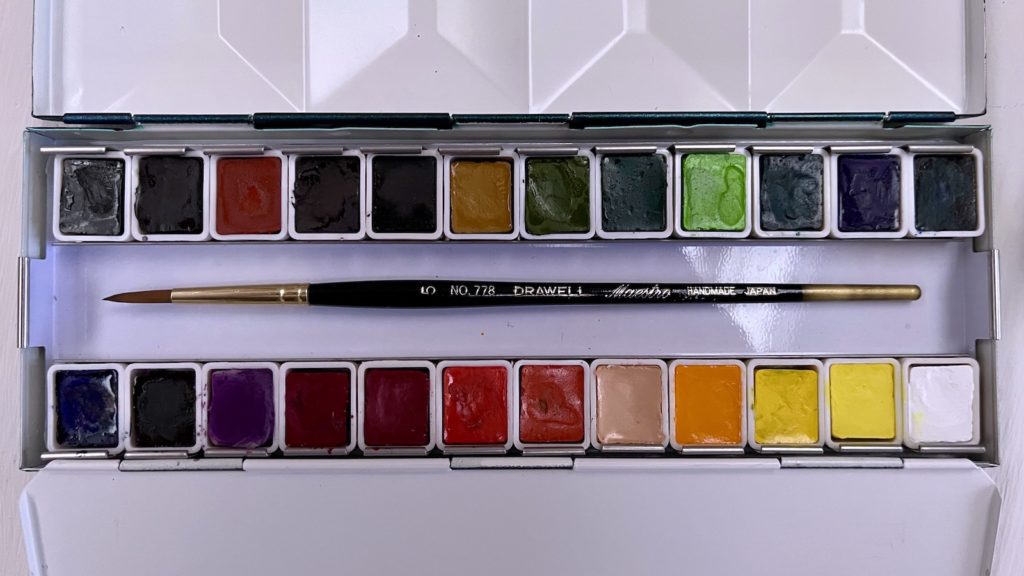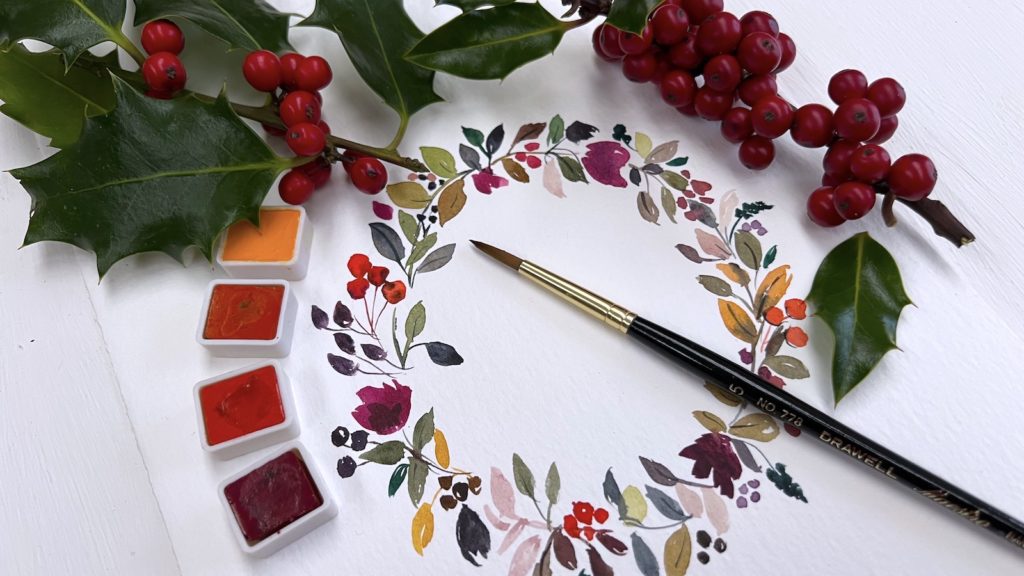Let’s find out what’s inside a tin of Emerald Paul Rubens paints and then see how to paint a simple little seasonal wreath for cards or other Christmas stationery.

The Product
The tin of paints comes in a very sturdy green box with embossed gold writing on it. It would prove a very good way of protecting the actual paints from any damp or damage.

The tin itself is pretty, having been sprayed with a glittery blue paint, but is not as sturdy as the tins supplied by A. Gallo or Winsor and Newton for example. The edges are fairly sharp although not dangerously so. But the closure is a bit insecure, and it might be a good idea to put an elastic band around the tin to hold it firmly closed. There’s plenty of space on the lit and inside flat for use as a palette, and the tray holding the paints comes out easily to allow cleaning.
Unwrapping the paints
First we take a look at the paints inside this glittery “emerald” tin of half pans. I spent a happy half hour unwrapping the tiny pans – the paper which protects them is quite hard to remove. But once they are all undressed, the little squares of color are like a box of candies and ready for work!

Testing the paints
Rubens supply a small card to swatch the colors on to, and in doing so it was noticeable that many of them are somewhat opaque, although they possibly behave like the Kuretake japanese paints which are opaque when undiluted, yet nice and transparent when water is added liberally.The colors of the paints are strong, with the exception of the Violet 440 which is slightly less intense than the other colors. However, it does mix nicely with Naples Yellow to make an attractive soft pink, so is excused for that reason.
The Naples Yellow is darker and thicker than I’m used to, and I don’t know yet whether it will give the same soft sky effect that my Winsor and Newton Naples Yellow produces. Time will tell.
Other colors of note – well, Burnt Sienna is noteworthy for its absence from the set. As a very useful brown which makes beautiful greys when mixed with blue, I would have to suggest buying an extra pan of Burnt Sienna to complete this set, and taking out the white, as I often do, to make space. Also missing is Raw Sienna, although Yellow Ochre is a cheaper substitute you might want to replace with the more transparent Raw Sienna. Still in the yellows, the Light Yellow Lemon and the Cadmium Yellow Hue are very similar to each other, on the acidic side, which is a shame as there is no really warm yellow like Cad Yellow Deep in the set.

As far as the greens go, there is a good selection of four, which would make good mixers, but I can’t imagine using any of them neat from the tin as they are too vibrant for my taste.
The Ultramarine is too intensely blue for my preference, and as Cobalt and Cerulean are both missing they would also need to be added, and at this stage I’m starting to think that for serious painting this set might not prove adequate in the long run.
However, for a serious beginner this set is more than good enough to start with and with a price point of less than $40 for the 24 colors. Together with a block of paper by Rubens for only $20 you are set to go for under $60 with quality paints and paper.

Seasonal Wreath Painting
I used a sheet of 140lb watercolor paper (cold pressed) to do my little autumn/winter wreath on. As it was just a try-out of the paints I was not too fussy about the brand, but did use a good weight of paper to give the paints a fair chance. You could try the Paul Rubens paper linked above.
On the subject of buying paper, it is much more economical to buy it in the sheet (22 x 30 inches) and cutting it into eight pieces, than to buy pads or sketchpads. Whilst both the latter have their place, for traveling and to save stretching for larger works, for everyday casual use and practice sheets are the logical choice.
Finally, here is the video. You can download the sketch of the painting here for free, or pay your own choice of price in the checkout.